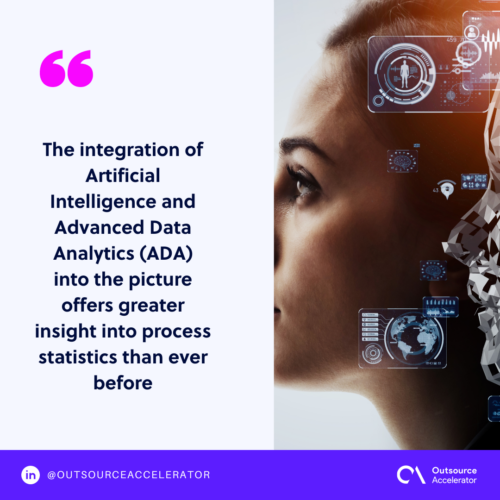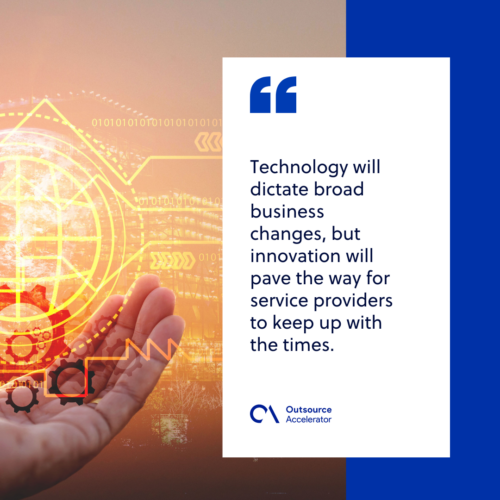BPO in the second roaring 2024

Digital transformation has reshaped businesses and the Outsourcing and Shared Services (OSS) industry in the last decade. As we enter a new decade, the business world experiences disruption at the forefront of impact technologies such as Intelligent Automation (AI) and Robotic Process Automation (RPA). These also make us rethink business processes.
With the disruption comes another impending transformation as business process outsourcing providers are also evolving to move with the times. This results in an industry where businesses and their outsourcing partners integrate AI within their processes. The product is a synthesized, harmonized, and collective platform where corporate strategy, data insights, AI decision-making, and communications intelligence come together.
The future of the industry as we know it will evolve and involve AI in various capacities. AI that serves as an aggregators of data, interpreter of data, and assistant will be dependable and indispensable in the future. It will also generate unprecedented weight on the capabilities of the business on value creation and value chain optimization.
A Collective Intelligence Platform
The integration of Artificial Intelligence and Advanced Data Analytics (ADA) into the picture offers greater insight into process statistics than ever before. We are generating data and learning data occurrences in real-time with the aid of AI-powered data interpreters.
For business analysts and corporate strategists, these hyperdata trends allow the enterprise to move quicker and adapt faster based on business circumstances. The once-invisible cost drivers, such as crisis response and value loss during adaptation, have become fixed business metrics. Departments around the world have become increasingly aware of advanced business analytics.

How collective intelligence works
Picture this process: AI at the forefront of the collective intelligence platform will act as data aggregators. Another AI platform will be in charge of the big data and hyperdata interpretation – churning and chewing data for interpretation of the business analysts.
From there, corporate strategists and department heads can respond in real-time by crafting policies and executing strategies that will lead to greater efficiency. This is the collective intelligence platform in action. To scale it as an industrial service or solution will be another profitable market for specialized outsourcing or solutions providers.
BPOs: An Amalgamation of Human and AI Interface
The myth that artificial intelligence will replace human specialists at the forefront of customer service and technical support layers has been dispelled through the existential use cases of solutions providers that mix processes involving BPO professionals who are aided by AI or cognitive applications.
The result is hybrid support for customer care in one of the use cases involving that alley. Drawing upon a knowledge base aggregated by cognitive software, a customer care specialist can handle even the most complex of questions in which the customer may ask.
Under this unfolding extraction of information versus knowledge stored from a knowledge base, the capacity of a customer care specialist is greatly augmented and in turn, customer retention or satisfaction rates will also improve in their reputation or scores.
Disruption and Innovation
Perhaps the greatest opportunities for BPOs and Shared Service providers are the emerging markets where specialty and niche-specific solutions can be made as a service.
In the age of Everything-As-A-Service, a service within a service may as well be grounds for innovation. As the world becomes smaller and everything becomes interconnected, professionals aided by technology are a welcome interface for communicating people with people.
Technology will dictate broad business changes, but innovation will pave the way for service providers to keep up with the times.

The setback and how to overcome it
However, while the market sees AI augmentation in BPOs, the transformation of automated processes impacts the low-skilled job brackets. According to ADB, the fourth industrial revolution will reshape and reformat the industry. Whereas the decline of low-end work in the industry will fall by as much as 47 percent from 2016 to 2022.
With this, businesses should encourage their workers to undergo training and development courses for skill enhancement. This can help them keep afloat with the changes in the industry.
Conclusion
Automation is reshaping the industry, and the time to innovate is within the disruption phase. BPOs that emerge with new, technology-aided solutions and “smarter” and more “skilled” professionals in working with automated tools are on the right track to prosper in the second roaring twenties.







 Independent
Independent




